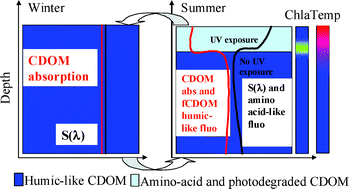In this study, we present results on seasonal and spatial changes in CDOM absorption and fluorescence (fCDOM) in a deep mountain lake (Salto Lake, Italy). A novel approach was used to describe the shape of CDOM absorption between 250–700 nm (distribution of the spectral slope, S(λ)) and a new fluorescence ratio is used to distinguish between humic and amino acid-like components. Solar ultraviolet irradiance, dissolved organic carbon (DOC), DOM fluorescence and absorption measurements were analysed and compared to other physicochemical parameters. We show that in the UV-exposed mixed layer: (i) fluorescence by autochthonous amino acid-like CDOM, (ii) values of S(λ) across UV-C and UV-B wavebands increased during the summer months, whereas (i) average molar absorption coefficient and (ii) fluorescence by allochthonous humic CDOM decreased. In the unexposed deep layer of the water column (and in the entire water column in winter), humic-like CDOM presented high values of molar absorption coefficients and low values of S(λ). UV attenuation coefficients correlated with both chlorophyll a concentrations and CDOM absorption. In agreement with changes in CDOM, minimal values in UV attenuation were found in summer. The S(λ) curve was used as a signature of the mixture between photobleached and algal-derived CDOM with respect to the unexposed chromophoric dissolved compounds in this thermal stratified lake. Furthermore, S(λ) curves were useful to distinguish between low and high molecular weight CDOM.

You have access to this article
 Please wait while we load your content...
Something went wrong. Try again?
Please wait while we load your content...
Something went wrong. Try again?


 Please wait while we load your content...
Please wait while we load your content...